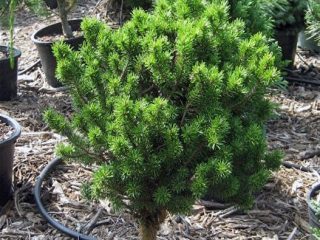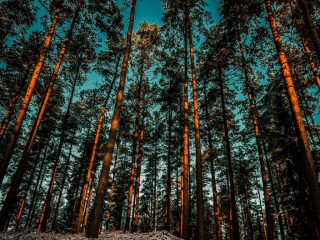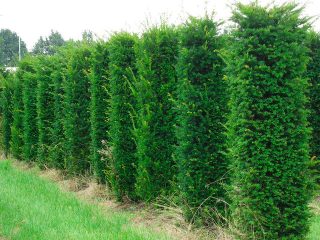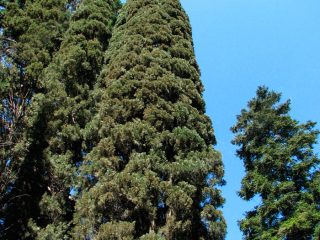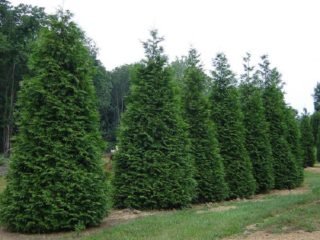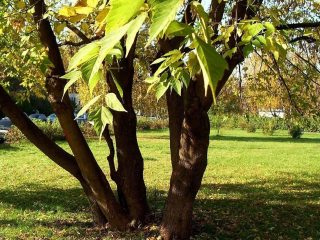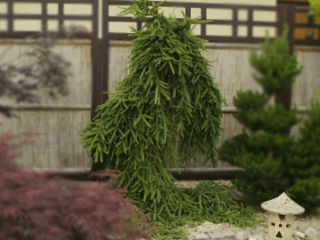Content
The pointed yew (Taxus cuspidata) is an evergreen and in most cases dioecious plant, which can take the form of a tree, shrub or dwarf tree, depending on growing conditions. Belongs to the yew family. In nature it occurs singly or in small groups. Nowadays, decorative varieties of pointed yew are especially popular among landscape designers and gardeners. However, their cultivation requires compliance with the basic requirements of the culture, which must be studied in advance.
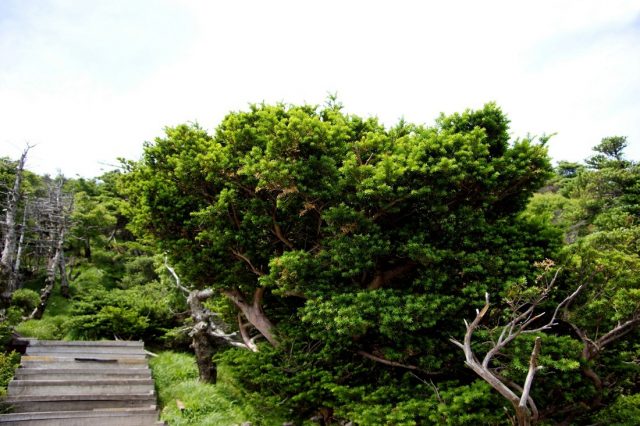
Acute yew is a rare plant species
Description of pointed yew with photo
This crop is a long-lived tree. The lifespan of the pointed yew is about 1.5-2 thousand years. The culture is characterized by a slow growth rate. The annual growth is 2.5-5 cm. Acuminate yew is listed in the Red Book of Russia.
In the forest, this coniferous plant can be easily recognized by its light, openwork and very dark crown. It has the shape of a cascade. The needles of the yew are soft, delicate, and pointed, which is what gave the species its name.On top it is a darker shade, glossy, and below it is matte and has two brownish-yellow stripes. The needles of pointed yew are 1.2-2.6 cm long and 2-3.5 mm wide. On vertical shoots it is arranged spirally, and on lateral shoots it is arranged in a ridge. The lifespan of yew needles is 4-6 years.
The bark of the trunk is red-brown in color and thin. You can see yellow-white spots on it, which is typical for this species. As the tree matures, the bark begins to peel off in long longitudinal strips. Young branches of the conifer are brick-brown.
The trunk of the pointed yew is disorganized, tapering, and has an irregular cross-section.
In the wild, the height of the tree can reach 20 m, but the most common specimens are about 6 m. The flowering period of the yew begins in May, and the fruits and seeds ripen in August-September. The cone berries of the conifer are ellipsoidal in shape. Inside them there is a seed, around which there is soft pink pulp with a whitish coating. When ripe, the berries become bright red.
The root system of this conifer is branched with numerous thin shoots.
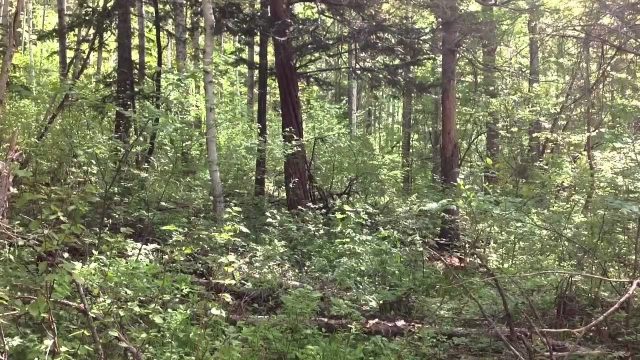
The wood of this conifer is resistant to rotting
Where does it grow
The Far East is considered the homeland of yew. But the tree is also found everywhere in Korea and Japan.
Prefers to grow on slightly alkaline loamy soils, rich in organic matter with good air permeability. Acute yew easily tolerates gas and dust in the air, is able to grow in the shade and in open areas, and is also little susceptible to drought.
Winter hardiness of pointed yew
This conifer has average frost resistance. It tolerates temperatures down to -35-40 °C. The tree suffers from drafts.
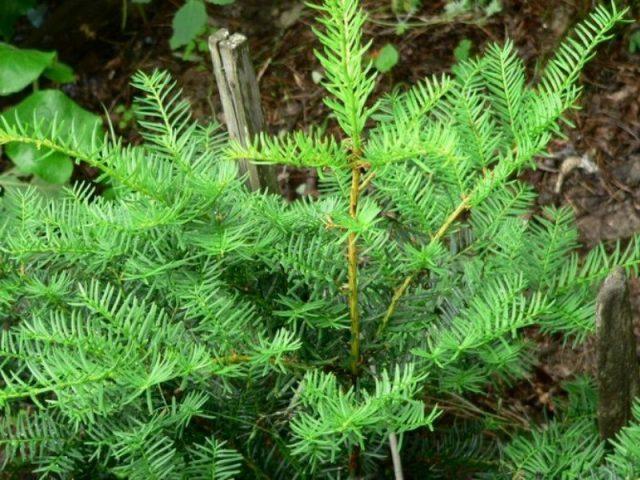
Acute yew is considered the most shade-tolerant conifer
Varieties of pointed yew
Thanks to selection, decorative varieties of the crop have been obtained that are widely used for landscaping. They have some differences between themselves, which allows you to choose the most suitable specimens, depending on the location and size of the site.
Pointed yew Nana
A dwarf variety of shrubby ephedra. The height of the plant at the age of 30 years is 1.5 m, and the width is about 2.6 m. The crown of the conifer is in the form of an irregular ellipse, cushion-shaped. The needles are dark green, pleasant to the touch. The branches are short and directed upwards.
Yew acuminate Nana grows up to 5 cm per year. It tolerates pruning well, so it is ideal for topiary, hedges, and can also be grown as a pot plant.
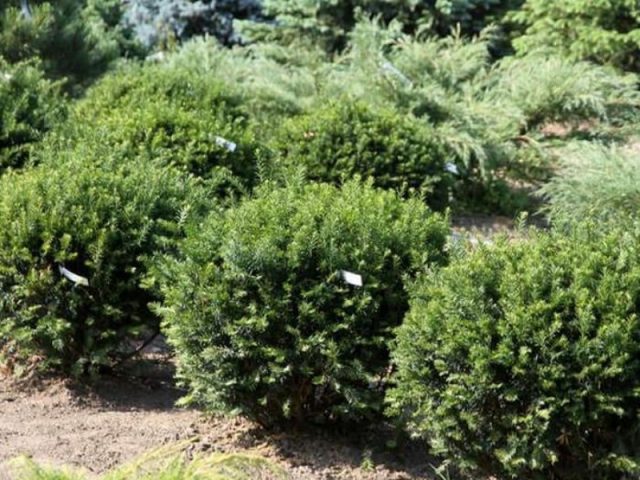
The Nana variety always bears fruit after flowering
Golden Yew
A semi-dwarf variety, the height of which reaches 1.2 m. The crown is flattened and irregular in shape. The branches of the Aurescens variety are directed upward. The shoots are short and numerous. The young growth has a bright yellow hue, which determined the name of the variety.
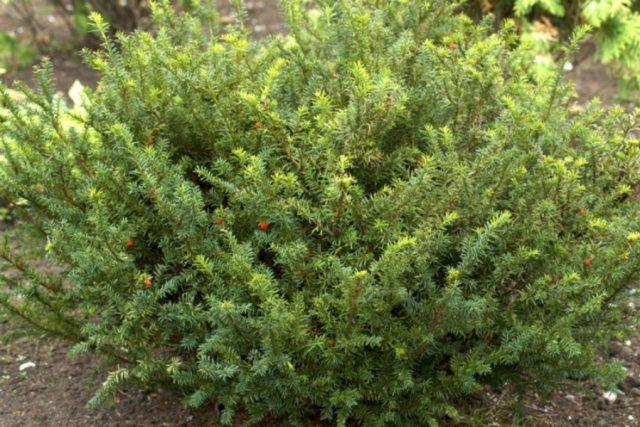
Golden Yew is ideal for small areas
Tees Farmen
A characteristic feature of this variety is a dense compact crown with dense branched branches. The height of the Farmen yew reaches 2 m, and the diameter of the bush is 3 m. The plant adapts well to urban conditions.
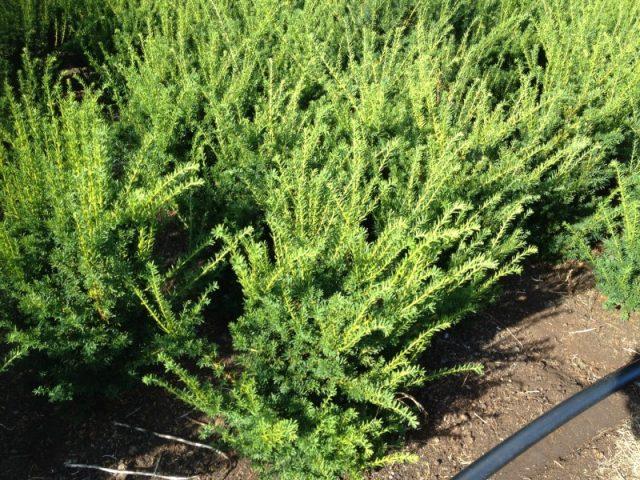
Yew Farmen does not tolerate poor, dry soil
Yew Minima
The Minima variety is the shortest of all ornamental species.The height of its bushes does not exceed 35 cm, and the width reaches 1 m. The branches have a brown tint. The needles of the Minima variety are oblong, emerald green in color, and shiny.
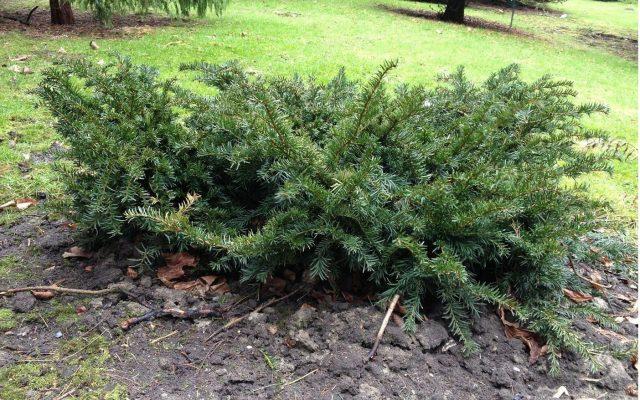
The Minima variety goes well with tall conifers
Yew Capitata
The Capitata variety can grow in one or more trunks. Its dense crown has a pyramidal shape. The branches are directed upwards. The young leaves of the plant have a yellow border, and as they mature they become green in color.
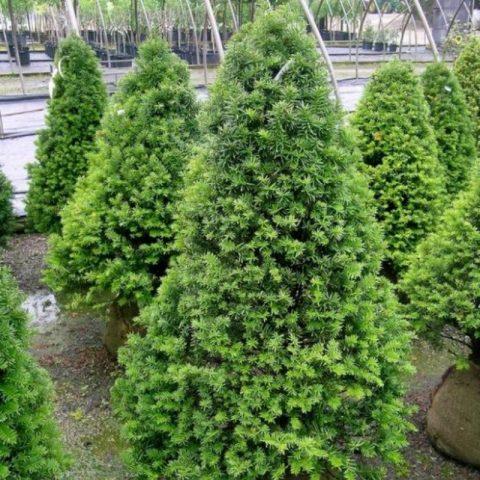
The Kapitata variety is able to fully develop even in poor soil
Advantages and disadvantages
Acute yew has many advantages. Therefore, the popularity of this conifer as an element of landscape design is growing. However, the perennial also has certain disadvantages that need to be taken into account when choosing it.
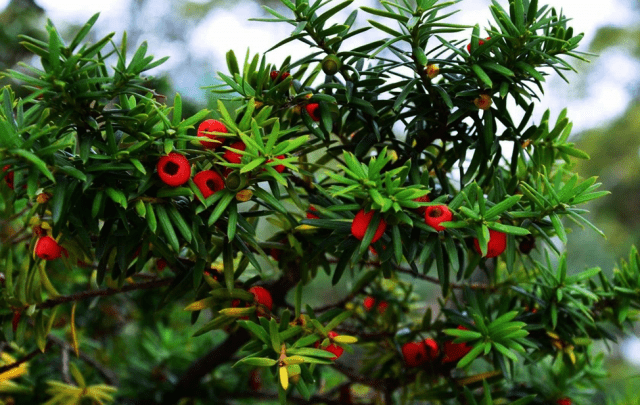
Acute yew begins to bear fruit at the age of 25 years
Main advantages:
- unpretentiousness;
- high decorative qualities;
- combines with other cultures;
- suitable for creating hedges and borders;
- drought resistant;
- tolerates haircuts well;
- sprouts on old wood;
- great life potential;
- shade-tolerant;
- easily adapts to urban conditions.
Flaws:
- slow growth;
- requires high air humidity;
- average frost resistance;
- all parts of the plant are poisonous.
Landing rules
Shaded places protected from drafts are suitable for pointed yew. Ephedra is undemanding to soil composition, but prefers neutral soil. It is recommended to plant the plant in a permanent place in early spring or late autumn. To do this, you need to prepare holes with a depth of up to 80 cm and a width of about 50 cm. A 10 cm layer of drainage should be poured onto the bottom, and the remaining space should be filled with nutrient mixture to 2/3 of the total volume.It should consist of turf, peat, sand and humus in a ratio of 3:1:1:1. You also need to additionally add 150 g of superphosphate and 70 g of potassium sulfide to the soil. Fertilizers must be thoroughly mixed with the soil.
When planting, the seedling should be placed in the center of the hole and the roots should be carefully straightened. After this, they should be sprinkled with earth, the voids should be carefully filled, the soil should be compacted at the base of the plant, and then watered abundantly. Upon completion, the root collar of the conifer should be at soil level.
Care instructions
The pointed yew belongs to the category of unpretentious crops. Therefore, the ephedra does not require complex care. However, its decorative effect directly depends on compliance with the rules of agricultural technology.
Only young conifers up to two years old need watering. For them, it is recommended to moisten them once a month at the rate of 10 liters of water per plant. An adult yew is capable of providing itself with moisture, since its root system deepens significantly. During hot periods, it is recommended to wash the plant needles using the sprinkling method.
It is recommended to feed yew twice a season. Fertilizers should be applied for the first time in the spring. At this time, you can use nitroammophoska at the rate of 60-100 g per tree. It is recommended to feed the pointed yew a second time in August, which increases its winter hardiness. During this period, you can use 80-120 g of superphosphate and 50-100 g of potassium sulfide. Fertilizer granules must be scattered into the root circle and embedded in moist soil.
Pruning the yew is necessary to give its crown a certain shape, as well as to remove damaged and shrunken branches. It is recommended to carry it out after winter.
Young yew seedlings need preparation for winter. To do this, in late autumn it is necessary to cover the root circle of the conifer with a layer of peat or humus 10 cm thick. After this, it is recommended to tie the branches of the plant with twine so as not to break under the weight of snow and cover it with spruce branches on top.
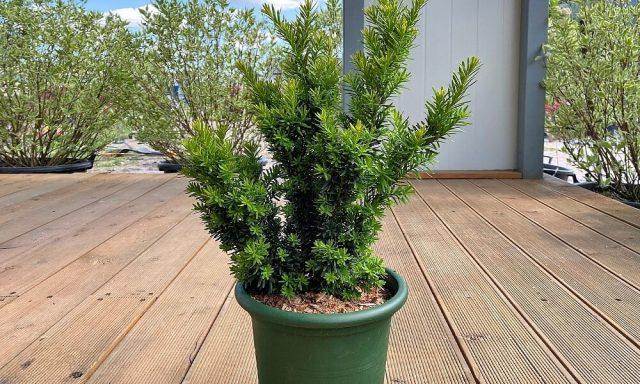
Ephedra does not tolerate stagnation of moisture in the soil
Reproduction of yew pointed
The culture propagates well by seeds and cuttings. In the first case, the preparation of planting material should be done in the fall and immediately sowed to a depth of 10 cm. This will ensure natural stratification of the seeds in winter. With the arrival of spring, shoots appear. Young seedlings require standard care.
To propagate yew by cuttings, you need to cut the apical shoots 15-20 cm long from branches 3-5 years old. The optimal period for this is April-May, September-October. At the bottom of the cuttings you need to remove the needles, and then put them in a Heteroauxin solution for a day. At the end of the time, it is necessary to plant them in a soil mixture consisting of peat and sand in a 2:1 ratio. Rooting occurs within 3-4 months.
Conclusion
The pointed yew is an ideal plant for decorative landscaping. It is tolerant of drought, poor soil and is undemanding to care. However, when choosing it, you need to take into account that it will take many years for the conifer to grow a lush crown.But this drawback is more than compensated by the plant’s good tolerance to pruning, which allows it to be given an intricate shape that will last a long time.

